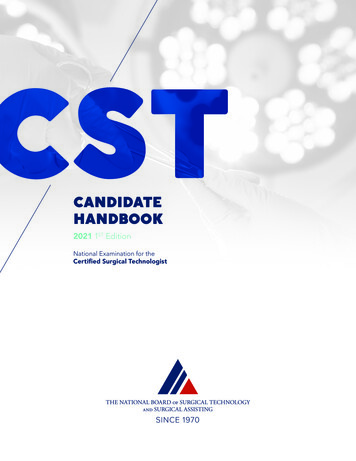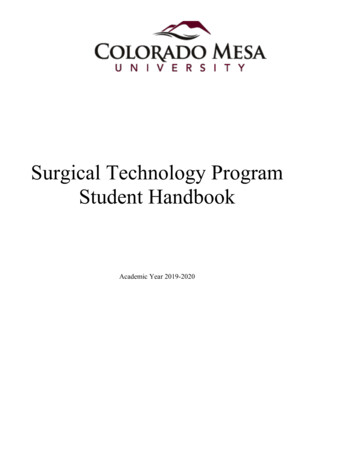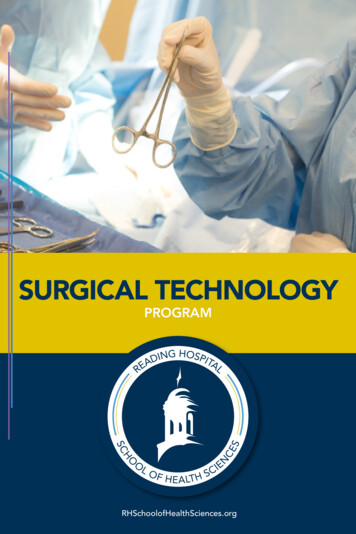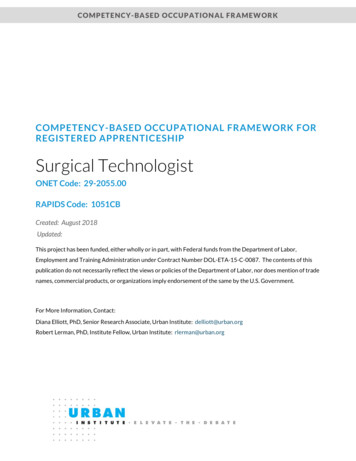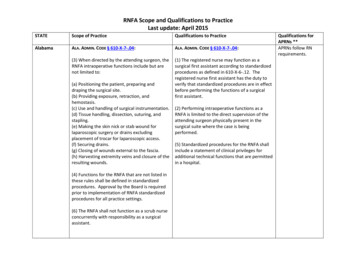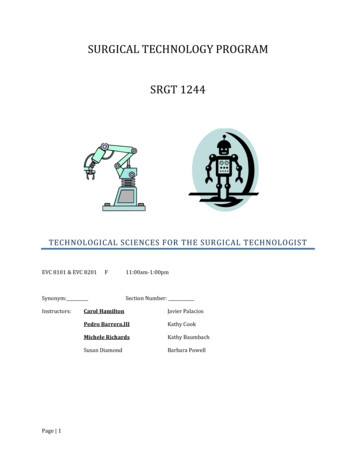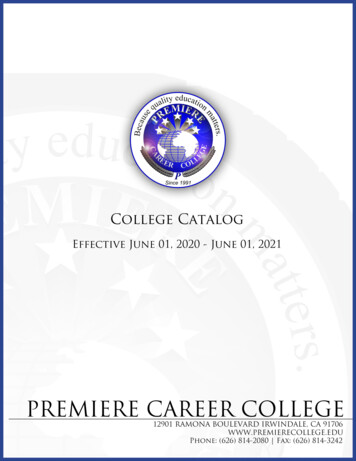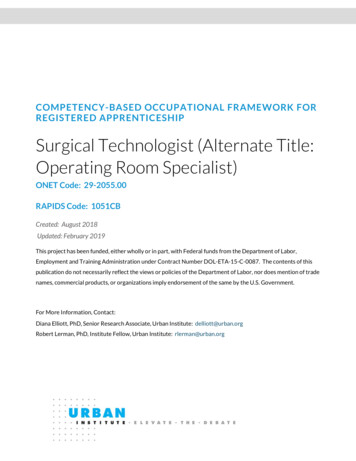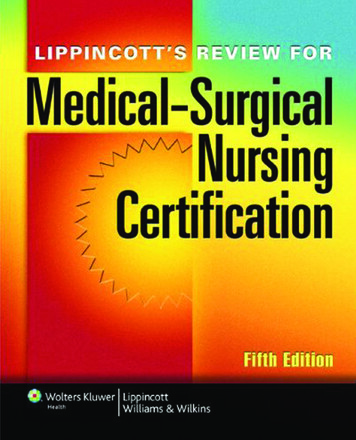
Transcription
The Surgical AssistantPu b l i sh e d Q uart e rl y by the As s ociation of Su rg ica l As s is ta n tsVOL. 19, NO. 3SUMMER 2013Inside:2013-2014 ASAElection Results12013-2014 ASAELECTION RESULTSClarification ofArticle “Appropriateuse of assistant atsurgery modifiersand payment indicators” published2/2/20123ASA Engages withBureau of LaborStatistics to DefineSurgical AssistantRole4Association ofSurgical Assistants IsWorking for You andthe Profession8Why ProgramAccreditation IsImportant10At the recent ASA Meeting in NewOrleans, elections were held for theoffices of president, vice president,treasurer and two positions on theBoard of Directors.All candidates participated in atown hall meeting after the businesssession concluded and addressedquestions from active ASA members.Candidates were also availableduring exhibit hours.On Saturday, May 30, ASA activemembers woke up early and voted at7:30 am.Results were announced at theBusiness Session which immediatelyfollowed voting.ASA 2013-2014 Board of DirectorsDennis Stover, CST, CSAPresidentDoug Hughes, CST, CSFA, CSAVice PresidentGreg Salmon, CST, CSFATreasurerKathy Duffy, CSFA, CSASecretaryChristie Ashcraft, CST, CSFADirectorPaul Beale, CST, CSFADirectorShannon Smith, CST, CSFADirectorVera Polly Thomas, CST, SA-CDirectorJodie Woods, CST, CSFADirector 2013 Association of Surgical Assistants. All rights reserved.
Please send resumes to careers@asainc.us1-855-816-7112
CLARIFICATION OF ARTICLE“Appropriate use of assistant at surgerymodifiers and payment indicators”PUBLISHED 2/2/2012Editor’s Note: In 2011, ASA recognized a significant amount of misinformation in Medicare billing andreimbursement that was being widely discussed. Accordingly, after seeking legal advice, we published thestatement that is located on the front page of the ASA website.First Coast, the Medicare Admini s trative Contractor for Jurisdiction 9 (Puerto Rico, US Virgin Islands and Florida)has clarified the language “incident to” regarding assistant at surgery services for assistant at surgery servicesbilled under the Medicare physician fee schedule. We regard this research as part of the ASA member benefitsand underscores the commitment ASA continues to fulfill to advance the practice of surgical assisting.First Coast published a detailed arti cle on 2/2/2012 which clearly articu lated Medicare’s coverage requirementsrelated to assistant at surgery servicesbilled under the Medicare physicianfee schedule. Please refer to this articleat t has come to the attention of FirstCoast that assistant at surgery servicesare being billed to Medicare Part B inMAC J9 which do not meet Medicare’scoverage requirements. It appearssome providers are billing the servicesof surgical assistants (e.g., certified firstassistants, registered nurse surgicalassistants, surgical technologists, etc.)under the performing provider numberof the surgeon performing the surgical procedure as if “incident to” provisions applied to the service. These services are being billed with an 80 modifier which indicates the assistant atsurgery services were rendered by anassistant surgeon. As noted in CurrentProcedural Terminology (CPT) andoutlined in First Coast’s February 2,2012 article, modifiers 80, 81 and 82are only appropriately appended tothe claim if assistant at surgery services were performed by a physician(surgeon). Modifier AS must be used ifassistant at surgery services were rendered by a Medicare covered non-physician provider type, which includesphysician assistants (PA), nurse practitioners (NP), nurse midwife or clinicalnurse specialists (CNS). Assistant atsurgery services rendered by “covered”non-physician practitioners billed withthe AS modifier receive the appropriatenon-physician payment reduction.In summary, Medicare Part B reimbursement for an assistant at surgery isonly appropriate when the procedure iscovered for an assistant at surgery andone of the following situations exists: The person performing the assistantat surgery service is a physician, or The person performing the assistant at surgery service is enrolled inMedicare as a physician assistant(PA), nurse practitioner (NP), nursemidwife, or clinical nurse specialist (CNS).Assistant at surgery services rendered by a surgical technician, a firstsurgical assistant, scrub nurse, or anyperson bearing a title other than physician, PA, NP, CNS or nurse midwifeare not payable by Medicare Part B andis not billable to the patient. Billing theservices of a non-covered assistant atsurgery under the surgeon’s performingprovider number is an inappropriateapplication of the “incident to” guidelines and any services billed in thismanner represents an overpayment tothe provider and must be refunded tothe Program.References Social Security Act Code of Federal Regulations IOM Manuals:Pub. 100-02, Medicare Benefit PolicyManual, Chapter 6, Sections 10-20;Chapter 15, Section 60Pub. 100-04, Medicare ClaimsProcessing Manual, Chapter 12,Sections 20.4.3, 110.1, 110.3 and 120.1 NHIC’s statement on assistant atsurgery services: r%20Billing%20Guide.pdf Trailblazer’s statement on assistant at surgery services: ning%20Manual/nonphysicianpractitioners.pdf July 2011The Surgical Assistant3
ASA ENGAGES WITHBUREAU OF LABOR STATISTICSTO DEFINESURGICAL ASSISTANT ROLEFor the first time, the United StatesBureau of Labor Statistics (BLS) isworking with ASA to develop a separate definition of the surgical assistant that is anticipated to be publishednext year. This definition will be a template for facility employers to complete and return. The discussions withthe Bureau of Labor Statistics havebeen very positive, and it looks promising that the national results would bepublished the Occupational OutlookHandbook in 2015. Median pay, information regarding the median pay, workenvironment, job outlook, employment outlook and required education for the surgical assistant practicewould be available. Currently, information regarding the surgical assistant hasbeen melded into the surgical technologist definition. Below is the information that has been provided to the BLSto help distinguish the two roles.Surgical Technologists Comparisonto Surgical AssistantsSurgical technologists and surgicalassistants should be classified as separate professions, as these professions4The Surgical Assistantare classified separately by employers,have separate educational pathways,certifications, professional associations, malpractice insurance requirements, insurance billing practices, andvarying hospital credentialing policiesand compensation. In addition, surgical technologists and surgical assistants have distinct state statutes andregulations in fourteen states withadditional legislation pending in others.Finally, surgical assistants’ and surgical technologists’ task and roles in theoperating room vary.
EDUCATION, CERTIFICATION, ORGANIZATIONAL,MANAGERIAL AND COMPENSATION DIFFERENCESSurgical TechnologistsSurgical AssistantsEducation/Pathway to EntrySurgical technology education program,military education programSurgical assisting education program; foreignmedical school; or surgical technologyeducational program with additional training (i.e.,135 cases); or surgical technology educationalprogram followed by work experience andseparate surgical assisting education program.EducationalAccreditationSurgical technology programs areaccredited by the Commission onAccreditation of Allied Health EducationPrograms (CAAHEP) and the AccreditingBureau of Health Education Schools(ABHES).Surgical assisting programs are accredited by theCommission on Accreditation of Allied HealthEducation Programs (CAAHEP). CAAHEP hasseparate accreditation standards and committeesfor surgical technology and surgical assistingprograms.Certifications Certified Surgical Technologist (CST)credential conferred by the NationalBoard of Surgical Technology andSurgical Assisting (NBSTSA); Tech in Surgery-Certified (TS-C)credential conferred by the NationalCenter for Competency Testing (notaccredited by the NCCA). Certified Surgical First Assistant (CSFA)credential conferred by the National Board ofSurgical Technology and Surgical Assisting; Certified Surgical Assistant (CSA) credentialconferred by the National Surgical AssistantAssociation (NSAA); Surgical Assistant-Certified (SA-C) credentialconferred by the American Board of on of Surgical Technologists(www.ast.org)Association of Surgical l orFacility Classification/Name BadgeCertified Surgical Technologist, SurgicalTechnologist or Operating RoomTechnicianCertified Surgical First Assistant, CertifiedSurgical Assistant, Surgical First Assistant orSurgical AssistantMalpractice insurancerequirementsSurgical technologists are generally notrequired to carry malpractice insurance.Surgical assistants are generally required to carrymalpractice insurance.Insurance billingSurgical technologists may not billinsurance companies for performing thesurgical technology role.Surgical assistants may bill insurance companies(except Medicare) for performing the surgicalassistant role.Hospital/FacilitycredentialingHospitals generally do not require surgicaltechnologists to be credentialed.Hospitals generally credential surgicalassistants under the auspices of the medical staffdepartment.CompensationAccording to the BLS, the median salary forsurgical technologists in 2010 was 39,920.Though BLS data is not available on surgicalassistants, surgical assistant compensation canrange widely.Similar professionsNurses also serve in the scrub person role.Surgeons, residents-in-training, registered nursefirst assistants and physician assistants alsoperform in the surgical assistant role.The Surgical Assistant5
REGULATORY DIFFERENCES6Surgical TechnologistsSurgical AssistantsCaliforniaSurgical technologists are unregulated.Surgical assistants must be licensed.ColoradoSurgical technologists must be registered as“surgical technologists.”Surgical assistants must be registered as“surgical assistants.”FloridaLegislation pending with separaterequirements for surgical technologists.Legislation pending with separaterequirements for surgical assistants.District of ColumbiaSurgical technologists are unregulated.Surgical assistants must be licensed.IdahoEducation and certification requirements inplace for surgical technologists.Surgical assistants are unregulated.IllinoisSurgical technologists may register as “surgicaltechnologists.”Surgical assistants may register as “surgicalassistants.”IndianaEducation and CST certification requirementsin place for surgical technologists.Certain surgical assisting functions may onlybe performed by licensed surgeons, physicianassistants, registered nurses or individuals whohold the CSFA credential from the NBSTSA.KentuckySurgical technologists are not regulated.Surgical assistants must be licensed.MassachusettsEducation and CST certification requirementsin place for surgical technologists.Surgical assistants are unregulated.MinnesotaLegislation pending for surgical technologists.The pending legislation does not apply tosurgical assistants.New JerseyEducation and certification requirements inplace for surgical technologists.Surgical assistants must be licensed assurgeons, physician assistants or nurses.New YorkLegislation is pending to create minimumeducation and certification standards forsurgical technologists.Surgical assistants must be licensed assurgeons, physician assistants or nurses.OhioLegislation pending for surgical technologists.The pending legislation does not apply tosurgical assistants.South CarolinaEducation and certification requirements inplace for surgical technologists.Surgical assistants are not regulated.TennesseeEducation and certification requirements inplace for surgical technologists.Surgical assistants are not regulated.TexasEducation and certification requirements inplace for surgical technologists.Surgical assistants may apply for licensureif they meet certain surgical assistanteducation and surgical assistant certificationrequirements.VirginiaLegislation pending with separaterequirements for surgical technologists.Legislation pending with separaterequirements for surgical assistants.WashingtonSurgical technologists must be registered assurgical technologists.Surgical assistants must be licensed asphysicians, physician assistants or nurses.The Surgical Assistant
EXAMPLES OF DIFFERENCES IN TASKSSurgical TechnologistsSurgical AssistantsPositioning the patientThe surgical technologist may perform thistask in collaboration with the registerednurse. circulator.Primarily the role of the surgical assistant.Placing retractorsSurgical technologists hold retractors afterplaced by the surgeon or surgical assistant.Surgical assistants may place retractors.Manipulation of tissueSurgical technologists generally do notdirectly manipulate tissue.Performed by surgical assistants. Surgicalassistants cut, clamp, tie, nibble, cauterize,suture and otherwise manipulate tissuesuch as skin, internal organs, bowels,nerves, blood vessels, etc.SuturingSurgical technologists prepare sutures.Surgical assistants suture tissue.Performed by the surgical assistant.Assisting with hemostasisClamping and cauterizingtissueSurgical technologists may applyelectrocautery to clamps, but generally notdirectly to tissue.Surgical assistants clamp and cauterizetissue (nerves, bowel, blood vessels, etc.)Tying and litigating tissuePerformed by the surgical assistant.Applying hemostatic clipsPerformed by the surgical assistant.Applying direct digitalpressureSurgical technologists may hold internalorgans, but generally do not apply pressureinside the surgical patient.Performed by the surgical assistant.Participating in volumereplacementPerformed by the surgical assistant.Providing assistance indrainagePerformed by the surgical assistant.Setting up operating roomequipment, instruments,solutions, medications andsuppliesPerformed by the surgical technologist.Gowning and gloving thesurgical teamThe surgical technologist gowns and glovesfirst, then gowns and gloves the surgicalteam.Perform counts withcirculatorPerformed by the surgical technologist.Passes instruments duringprocedurePerformed by the surgical technologist.Cleans and preparesinstruments for terminalsterilizationPerformed by the surgical technologist.The surgical assistant is gowned and glovedby the surgical technologist.The Surgical Assistant7
A ssoci at ion ofSu rgic a l A ssista n t sIs Wor k ing forYou a n d t h e P rof essionDennis Stover, CST, CSA, ASA PresidentFor the last three years, ASA has been growing andmembership now exceeds 1,000. There are somesolid reasons that have contributed to this growth andundoubtedly some benefits that ASA has developed thatmembers may not realize.In our initial surveys, we listened to members andprospective members about the benefits they werelooking for in their professional surgical assistingorganization. Here are some of the points that wererepeatedly mentioned in the wish lists.1. Educational hands-onworkshops targeted to thesurgical assistantASA has sponsored several higher levelworkshops in various locales including Chicago, Illinois; Houston, Texas;Miami, Florida; Naples, Florida; NewOrleans, Louisiana; and San Francisco,California. These learning opportunities have encompassed HighSpeed Drill Workshop; Beginningand Advanced Robotics Workshops;Advanced Wound Closure; OrthopedicCadaver Labs; Endovein Harvestingand Sim Surg; and Advanced Suture.In 2011, ASA sponsored the firstLearning at Sea Cruise and will againsponsor a cruise in Fall 2013 that willoffer up to 18 continuing educationcredits8The Surgical AssistantIn 2014 in Denver, ASA, will sponsoran all-day casting workshop. Details tocome in the near future.2. Legislative Efforts Focusingon the Surgical AssistantThe last two years have witnessedunprecedented legislative actions inVirginia and Florida (seeWinter 2012 and Spring 2013 issues ofThe Surgical Assistant for summaries).ASA, was the single professional surgical assistant organization that providedfinancial support and partnered withAST and the two representative stateassemblies of surgical technologists togenerate support for bills that wouldadvance both roles. ASA member duesprovided 32,000 in legislative supportlast year.3. Development of ASAStrategic PlanBeginning in 2010, ASA developed andpublished a strategic plan for the organization. The latest update was published in Fall 2012 in The SurgicalAssistant. This strategic plan providesmembers with the current and futuregoals, as well as the strategic goals, ofthe Association of Surgical Assistants.ASA is the only professional organization openly providing its members withthis information.4. Revision of the SurgicalAssisting Core CurriculumThe Board of Directors for theAssociation of Surgical Assistantsappointed surgical assistants and surgical assistant representatives fromthe Accreditation Review Councilon Surgical Technology and SurgicalAssisting (ARC/STSA) and theNational Board of Surgical Technologyand Surgical Assisting (NBSTSA) toupdate and revise the Core Curriculumfor Surgical Assisting. This important educational publication ensuresthat all surgical assisting studentsstudy and master the same benchmarkinformation. The Core Curriculumhas also been employed in legislative
discussions and provides legislativebodies with the details of the surgicalassistant role. The publication date isFall 2013. ASA member dues fundedthis effort.Committee is to have all three completed by Fall 2013. ASA member duesmade this effort possible.6. Jobs Board5. Surgical AssistingStandards of PracticeIn 2012 in Washington, DC, duringa panel discussion with attendees, acommitment was made to developRecommended Standards of Practicefor Surgical Assistants. Over thenext 12 months, the ASA EducationCommittee researched two standards – Trocar Insertion and Injectionof Local Anesthetics. In addition,the committee is also researchinga Guideline Statement that wouldaddress support of the ASA JobDescription. The goal of the EducationRecently, ASA introduced its onlineJobs Board. After debating the advantages and disadvantages of restricting access, the ASA Board determined that the Jobs Board shouldremain open for all to see in support ofadvancing the profession. Companiesand organizations seeking to recruitsurgical assistants will pay a competitive fee; ASA dues-paying memberswho wish to post their requirementsfor a position will be able to do this atno charge. ASA member dues supportthe Jobs Board.7. FacebookAlways open, the ASA Facebook pagebrings practitioners together. The ASABoard of Directors has determined thatFacebook continue to remain an openresource in order to support the profession and the practitioners. ASA member dues support Facebook.There is certainly much more to do andwe invite you to contact us and shareyour wishes for future directions. Inreturn, I ask that you encourage yoursurgical assistant colleagues in the OR,on Facebook or the Discussion Board—to join ASA—we are working solidly onbehalf of this profession and with moremembers, we can accomplish even more.Your commitment to membership isgreatly appreciated.Your vessel harvest is done, but the impact of the conduitquality on cardiac bypass outcomes is just beginning.The new VirtuoSaph Plus Endoscopic Vessel Harvesting System helpsdeliver a conduit you can have confidence in every time. Simple, one-step coagulate-and-cut mechanism delivers low targetedenergy at the tunnel wall away from the main conduit Advanced spot cautery provides direct cauterization in the tunnel Longer effective dissector length with V-Glide PTFE surface Open system and ergonomic design just like the original VirtuoSaph systemThere’s an ongoing need
TO DEFINE SURGICAL ASSISTANT ROLE For the first time, the United States Bureau of Labor Statistics (BLS) is working with ASA to develop a sep - . Positioning the patient The surgical technologist may perform this task in collaboration with the registered nurse. circulator.
